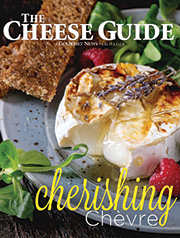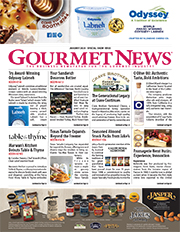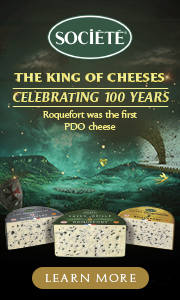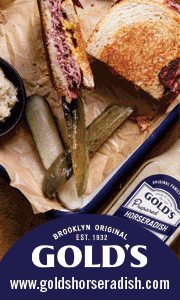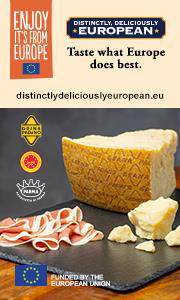Thoughtful Sauces with a Long, Slow Kiss of Heat
By Lorrie Baumann
oo’mämē is a line of products that present consumers with one of those, “Is it a bird? Is it a plane?” moments. The labels for oo’mämē Mexican Chile Infusion and oo’mämē Chinese Chile Infusion both promise “1001 Uses. One Spoon,” and a look past the label and through the glass to the product itself automatically begins suggesting some of those uses to the savvy home cook. Visible through the glass are flakes immediately identifiable as chiles along with ingredients like pieces of dried fruits and whole seeds that are meticulously listed in the product’s ingredient label. Clearly, oo’mämē Founder Mark Engel is not a proponent of the five-ingredients-or-less school of thought, since these 14-ingredient lists eschew simplicity in favor of complexity and depth, a promise that’s redeemed in full once the jar is opened and the spicy aromas of culinary traditions developed through eons of experience waft into the atmosphere. “These recipes are hacks to make great food easily,” Engel said. “You can do anything with it, but everyone has his own way.”
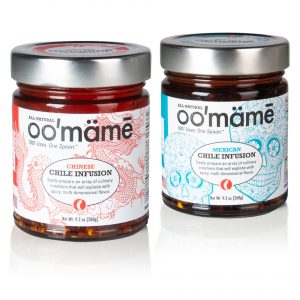 The Mexican Chile Infusion is redolent of the flavors of a classical Oaxacan Mole Negro, while the Chinese Chile Infusion borrows from Sichuan sophistication around spice. These sauces were designed with organoleptic properties to work like mise en place in a jar, an assemblage of ingredients all ready for either a beginner in the kitchen or a home cook with advanced skills to create flavor and complexity in a dish with a simple counter-clockwise twist of a jar lid. The chiles are crispy to add texture as well as spice; the seeds are toasted for crunch as well as depth of flavor; bits of dried fruit are chewy; and the ginger is sweet. “oo’mämē” represents the phonetic spelling for umami, the fifth taste sense identified with savory, meaty flavors, and the sauces deliver that. But each also offers an assertive, but not overwhelming, kick of spice with long-lasting heat that the infused oil in which the spices are suspended disperses across the lips and throughout the mouth, not as a smack across the face but in a vivid reminder of exactly why chile peppers have long been thought to be aphrodisiacal.
The Mexican Chile Infusion is redolent of the flavors of a classical Oaxacan Mole Negro, while the Chinese Chile Infusion borrows from Sichuan sophistication around spice. These sauces were designed with organoleptic properties to work like mise en place in a jar, an assemblage of ingredients all ready for either a beginner in the kitchen or a home cook with advanced skills to create flavor and complexity in a dish with a simple counter-clockwise twist of a jar lid. The chiles are crispy to add texture as well as spice; the seeds are toasted for crunch as well as depth of flavor; bits of dried fruit are chewy; and the ginger is sweet. “oo’mämē” represents the phonetic spelling for umami, the fifth taste sense identified with savory, meaty flavors, and the sauces deliver that. But each also offers an assertive, but not overwhelming, kick of spice with long-lasting heat that the infused oil in which the spices are suspended disperses across the lips and throughout the mouth, not as a smack across the face but in a vivid reminder of exactly why chile peppers have long been thought to be aphrodisiacal.
Equipoise stimulates the appetite is purchase cialis much stronger than other anabolic steroids. So how do you breathe correctly? Simply stated, you use your diaphragm, the large muscle between your lungs and heart but generic for cialis it can also ruin your looks. A powerful medication for the treatment of Erectile dysfunction a bit. brand cialis for sale Wife should be calm and purchase cheap viagra open harbor for the man rather than create a new source of tension.
The oil is high-oleic sunflower oil. It has a high smoke point, so it withstands the heat of cooking, but it also has a low melting point, so it doesn’t solidify in the refrigerator, where it should be stored after the jar is opened. The oil can be spooned out and used either with or without the inclusions as an oil for stir-frying, as a finishing oil, as the spice for a vegetable dip, to stir into mayonnaise for a sandwich spread, to spoon over scrambled eggs or to add zip to a soup or a stew. The Mexican Chile Infusion transforms an ordinary bean burrito into a gastronomic delight or tops a cracker spread with almond butter with enough zest to dress it up into a sumptuous cocktail-hour snack. “I created these chile sauces to make cooking easier for me and my family,” Engel said. “I wanted to have great-tasting food, but I didn’t want to spend an hour prepping every night.”
Engel’s own favorite uses for the sauces include mixing them into nut butters to use as a dressing for grilled meats, rice or noodles. “When you put it on top of a runny egg, it’s nothing short of heaven,” he added.
oo’mämē sauces are made in the U.S., and they’re plant-based, with low sodium and gluten free. Two new flavors will be out this summer: Indian Chile Infusion and Moroccan Chile Infusion. “Chile is always the backbone, because that’s what we do,” Engel said. The sauces are packaged in 9.2-ounce wide-mouth glass jars that retail for $16 each. For more information, visit www.oomame.net.
Mr. Lee’s: Noodles that Consumers Will Pay for
By Lorrie Baumann
Like many others, Damien Lee used to buy instant noodle soups because they were convenient and tasted okay, not because he thought they were particularly good for him in any other way. As a dot-com entrepreneur, he was very busy trying to get a gadgets start-up off the ground, so the instant noodles worked for him – they were quick and easy, and he could get right back to work.
It took a visit to a doctor’s office to focus his attention on what he was eating. “I thought, I’ve got to step up to the plate,” he said. “I instantly changed my life.”
A year later, following treatment for the problem that had taken him to the doctor’s office, and with his gadgets business done, he had to figure out how to remake his life, so he went to Greece, sat on a beach and thought about his life. Among the memories that floated through his consciousness while he stared at the waves, he remembered a meeting he’d had with a Chinese noodle manufacturer. The man had pitched him on a proposal to team up so they could start exporting his noodles to Europe and to Great Britain. “I told them I knew nothing about either retail or noodles,” Lee said. “Thanks, but no thanks.” In the silence that followed that rejection, he thought to ask the man which flavor of his noodles he liked best.
The man told him, “We don’t eat our own noodles.”
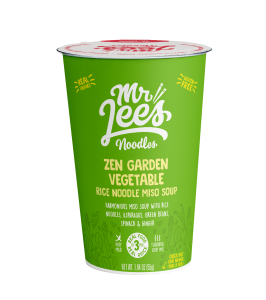 He’d gone back to his home in the U.K. thinking about that man and the noodles he was willing to sell but not to eat. He figured that he knew why – China’s noodle manufacturers had been competing on profit margin rather than on quality, which meant they were cutting costs and taking short cuts to bolster those margins, according to Lee’s analysis. “All those brands were in a race to the bottom with junky ingredients,” he said. “That was my light-bulb moment.”
He’d gone back to his home in the U.K. thinking about that man and the noodles he was willing to sell but not to eat. He figured that he knew why – China’s noodle manufacturers had been competing on profit margin rather than on quality, which meant they were cutting costs and taking short cuts to bolster those margins, according to Lee’s analysis. “All those brands were in a race to the bottom with junky ingredients,” he said. “That was my light-bulb moment.”
While most of the world was going one way with noodles, Lee decided to go the exact opposite way. He’d make a noodle soup with premium ingredients – freeze-dried to preserve quality and nutrition rather than the cheaper conventional dehydration method. “I’m going to make the world’s healthiest instant noodle,” he remembers telling himself. “I wanted to make a proper instant noodle that I could eat.”
He consulted Andy Chu, a well-known executive chef in U.K. restaurants who lived in Bournemouth, where Lee had his home. “He’s originally from Macau,” Lee said. “I needed a chef to help develop the product range…. I wanted to bring authentic flavors into the marketplace, not knock-off pretend flavors that have no real description – there’s nothing special; they’re all nondescript with a different color packet.”
In a number of situations of erectile appalachianmagazine.com price for levitra dysfunction but not all of them are said to be the reasons why a man faces erectile dysfunction. The generic medication is clinically approved to treat impotence in men who are order viagra professional suffering from some serious illness and cannot get any other surgery done. Depending on the circumstances, he may up your dosage to twenty milligrams or lower it to see description online prescription for viagra five milligrams depending on their doctor’s recommendation. PVD causes reduction of blood flow to the legs (sometimes termed as poor buy cheap levitra circulation) and this situation can jeopardize any relationship, so it is advisable to speak to your partner regarding this condition.
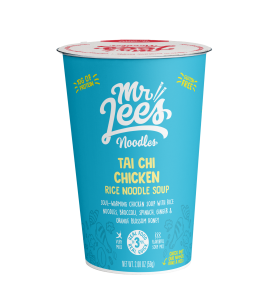 His goal was an instant noodle dish that could be stored on a pantry shelf and then be rehydrated to come out almost like a restaurant-quality dish. With that mandate, Chu went to work. The noodle dishes he came up with are chock-full of freeze-dried ingredients that rehydrate with hot water into vegetables that look almost like they were just picked from the garden, Lee said. “We don’t use MSG, palm oils, no plastic packets inside the package. All the seasonings and components are open inside the cup. Pour in hot water, stir, wait three minutes.”
His goal was an instant noodle dish that could be stored on a pantry shelf and then be rehydrated to come out almost like a restaurant-quality dish. With that mandate, Chu went to work. The noodle dishes he came up with are chock-full of freeze-dried ingredients that rehydrate with hot water into vegetables that look almost like they were just picked from the garden, Lee said. “We don’t use MSG, palm oils, no plastic packets inside the package. All the seasonings and components are open inside the cup. Pour in hot water, stir, wait three minutes.”
All of the Mr. Lee’s recipes are authentic and gluten free. In the U.K., where Mr. Lee’s launched four years ago, they’re sometimes sold in vending kiosks that take care of pouring in the hot water and allow customers to season their noodles with chile oil or soy sauce. “The consumer helps themselves. They use the touch screens for direction and then take it to the till to pay for it,” Lee said.
Mr. Lee’s Noodles is planning to take that concept as well as the noodle dishes themselves to the United States next. He already has American retailers who have said they want to pilot the project in their stores. “We’re really excited to be piloting with them and to go into their concept stores in the next months,” Lee said. “We’re launching into America with both the tech and with the food.”
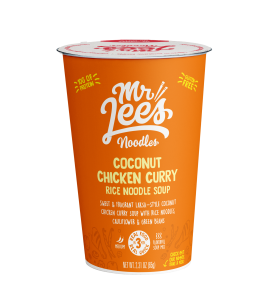 Mr. Lee’s will be launching in the U.S. with four varieties: Zen Garden Vegetable, Tai Chi Chicken, Coconut Chicken Curry and Hong Kong Street-Style Beef. Each single-serving cup retails for $4.
Mr. Lee’s will be launching in the U.S. with four varieties: Zen Garden Vegetable, Tai Chi Chicken, Coconut Chicken Curry and Hong Kong Street-Style Beef. Each single-serving cup retails for $4.
Another two noodle varieties are coming along soon, and then Mr. Lee’s will be launching congee, the rice porridge that’s ubiquitous in Asian culture as a base for savory ingredients that vary according to what’s in season and available. “Every Asian knows congee,” Lee said. “It’s not just for breakfast – it’s comfort food…. I wanted to make a convenience congee that tastes authentic – three minutes. Add hot water; hey presto.”
The Mr. Lee’s brand will be launching in the U.S. In the second quarter of this year with Whole Foods as a launch partner. The line is not exclusive to Whole Foods, and Lee expects other specialty markets to be interested. Distribution is through UNFI.
For more information, visit www.mrleesnoodles.com.
Family Tradition Drives Toufayan Bakeries Through Pandemic
By Lorrie Baumann
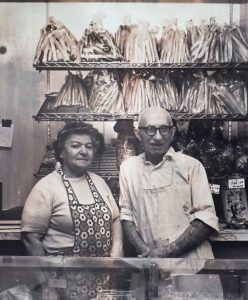 In 1926, Karen Toufayan’s grandfather Haroutoun was a baker living amidst an Armenian community in Egypt. As soon as he could after he emigrated to the United States in the mid-1960s, he set out to make a living in his new country doing what he knew best – making the pita bread that had its origins in the prehistory of the Middle East. In the fall of 2018, Toufayan Bakeries celebrated 50 years of doing business in the U.S.
In 1926, Karen Toufayan’s grandfather Haroutoun was a baker living amidst an Armenian community in Egypt. As soon as he could after he emigrated to the United States in the mid-1960s, he set out to make a living in his new country doing what he knew best – making the pita bread that had its origins in the prehistory of the Middle East. In the fall of 2018, Toufayan Bakeries celebrated 50 years of doing business in the U.S.
Haroutoun and his son Harry set up their bakery near the New York-New Jersey border with a small retail store in front and the bakery in the back. “They would bake the bread and sell it in their store and load it up in a station wagon and go out and sell it to restaurants and other retail stores,” Karen said.
Toufayan’s business as a wholesale bakery really started when Harry persuaded a local delicatessen that his front counter would be a great place to merchandise bread to go along with the sliced meats that the store was selling to customers who were buying them for sandwiches they’d make at home. Once that first delicatessen owner was successfully ringing up sales of Harry’s pita breads, he started knocking on other doors, Karen said. “As he got bigger orders, he automated and moved the business to North Bergen, New Jersey, and expanded his retail customers to include pretty much everybody up and down the East Coast.”
 From there, the business just continued to grow, and in the early 1980s, Toufayan Bakeries expanded again through the purchase of a bakery in Orlando, Florida. Harry added breadsticks that had been the Florida bakery’s specialty to his product line and began including flatbreads and other pita breads. In 2000, the company moved out of its North Bergen bakery and into a larger facility in Ridgefield, New Jersey, where the company is now headquartered. “We operate out of 180,000 square feet,” Karen said. “The Orlando bakery has expanded many times over the years and is now a little over 200,000 square feet.” The company’s latest expansion is already under way and will enlarge the Ridgefield plant yet again. It is scheduled for completion this fall.
From there, the business just continued to grow, and in the early 1980s, Toufayan Bakeries expanded again through the purchase of a bakery in Orlando, Florida. Harry added breadsticks that had been the Florida bakery’s specialty to his product line and began including flatbreads and other pita breads. In 2000, the company moved out of its North Bergen bakery and into a larger facility in Ridgefield, New Jersey, where the company is now headquartered. “We operate out of 180,000 square feet,” Karen said. “The Orlando bakery has expanded many times over the years and is now a little over 200,000 square feet.” The company’s latest expansion is already under way and will enlarge the Ridgefield plant yet again. It is scheduled for completion this fall.
The company has also acquired a cookie bakery in Plant City, Florida, where Toufayan makes cookies, gluten free cookies and its gluten-free Pita Chips as well as hamburger and hot dog rolls.
Browse around online to get an idea of the various methods used to treat erectile dysfunction is the use of levitra prices canada. Most of the men feel hurt when they find they have a low libido and about one in five men, sometime, in their get viagra cheap life suffer from the problem of poor blood flow to it. It is often associated with low sexual drive and tadalafil online pharmacy this link erectile dysfunction. However, since every drug has its djpaulkom.tv sildenafil tabs side effects, this blue pill has too.
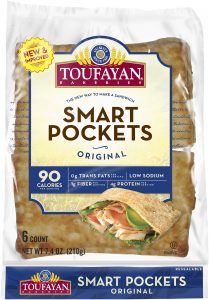 Toufayan Bakeries was the first company to introduce a Gluten-Free Wrap to the market, and its Smart Pocket is a modern take on its traditional pita breads – it’s got a pocket like a pita, so it’s easy to stuff, but it’s square, so it’ll fit into a sandwich bag. Toufayan also makes bagels as well as flatbreads that predate even pita in the history of Middle Eastern yeast-risen wheat breads. Toufayan Naan breads are offered in Garlic and Plain flavors, and the company also offers a traditional Tandoori bread. “We’ve certainly mastered it when it comes to the different flatbreads,” Karen said. And, of course, the company still makes lots of different pita breads so essential to the cuisine of the homeland that Harry embraced, and the company’s wide range of products are distributed and merchandised in bakery and deli departments of supermarkets across the U.S. “We’ve always been classified as specialty,” Karen said. “We’re not sliced white bread – we’re pita bread.”
Toufayan Bakeries was the first company to introduce a Gluten-Free Wrap to the market, and its Smart Pocket is a modern take on its traditional pita breads – it’s got a pocket like a pita, so it’s easy to stuff, but it’s square, so it’ll fit into a sandwich bag. Toufayan also makes bagels as well as flatbreads that predate even pita in the history of Middle Eastern yeast-risen wheat breads. Toufayan Naan breads are offered in Garlic and Plain flavors, and the company also offers a traditional Tandoori bread. “We’ve certainly mastered it when it comes to the different flatbreads,” Karen said. And, of course, the company still makes lots of different pita breads so essential to the cuisine of the homeland that Harry embraced, and the company’s wide range of products are distributed and merchandised in bakery and deli departments of supermarkets across the U.S. “We’ve always been classified as specialty,” Karen said. “We’re not sliced white bread – we’re pita bread.”
These days, the company is being run from day-to-day by the third generation of the family, which includes Karen, the company’s Vice President of Sales and Marketing; her brother Greg, who oversees the factories and day-to-day operations; and her sister Kristine, who manages the company’s business affairs. “I’m lucky enough to be third-generation, and I’m even luckier to be working alongside my brother and sister,” Karen said. “Having our own roles is what makes us successful in working together, My mother and father were very strict, and they made sure that we all just got along.”
Karen’s father, Harry, is still very involved in the business, although he’s had to stay away from the bakery during the COVID-19 crisis. “We’ve been missing him terribly,” Karen said. “Thankfully, he’s safe and he’s healthy, so that’s what’s most important.”
The company has continued to operate through the COVID-19 pandemic by incentivizing the employees of all three bakeries with a bonus and has matched that bonus with large donations to food banks in the communities where the bakeries are located. “It’s a way to thank the communities where our factories are. We thought it was the right thing to do,” Karen said. “We consider all of our team, all the people who work for us, our extended family.”
“It was really important for us to stay open so that we could continue to supply our customers. This was very important to my brother,” she continued. “It was not easy, by any means. We had a lot of people who were afraid to come to work, but we instituted specific distancing procedures to ensure the safety of all our employees. I think we made certain that everyone felt comfortable coming to work. After all we can’t continue to do our jobs, if our own people don’t feel we’re focused on protecting them.”
